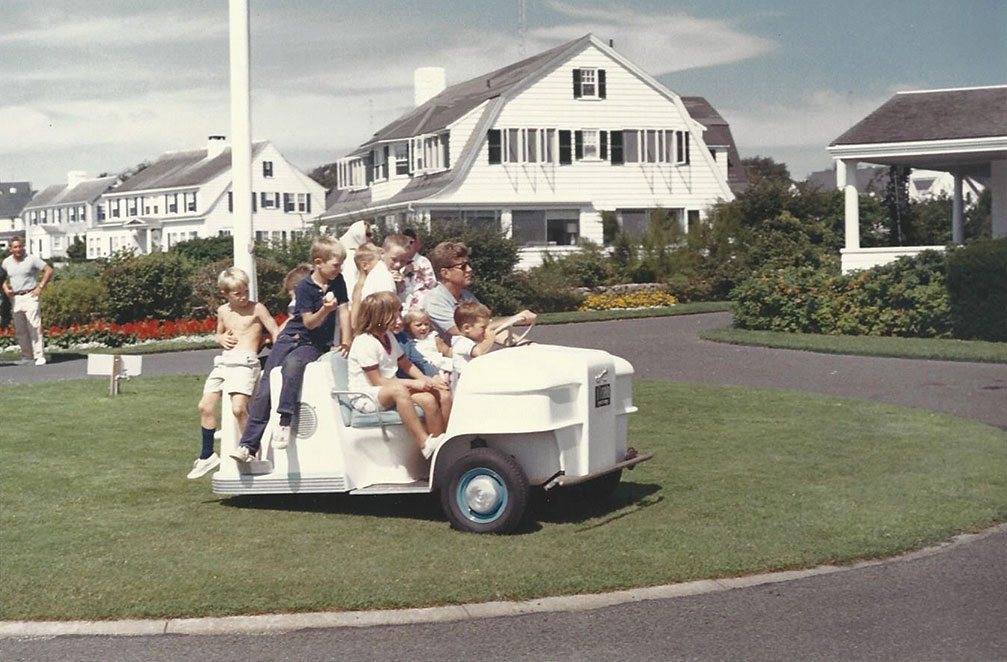
For JFK, Hyannis was Home, Haven and Political Headquarters
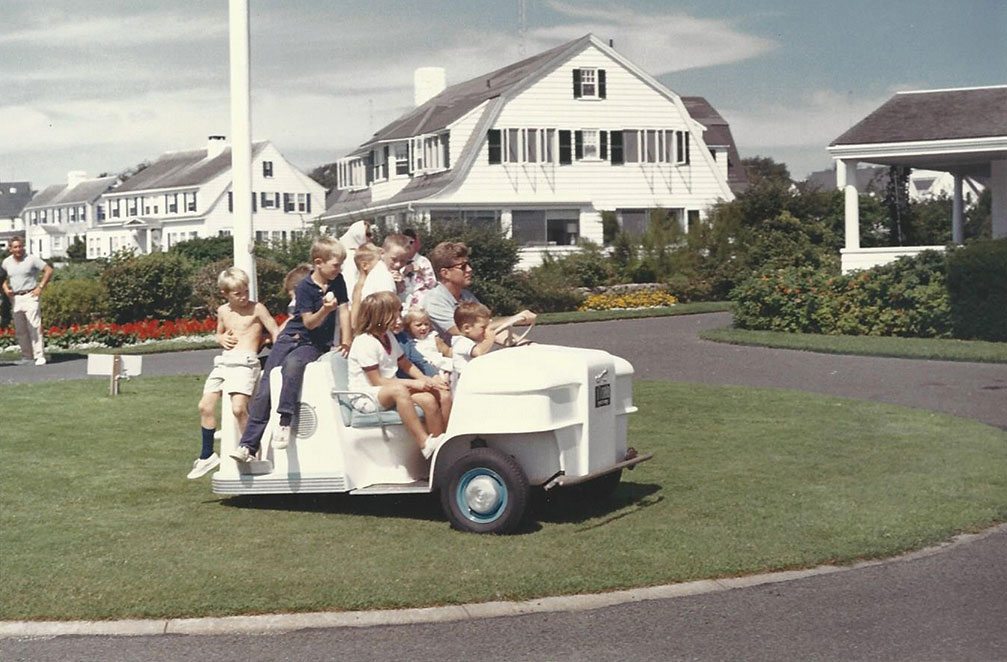
From Cape Cod Life Magazine
Despite his privileged life—or perhaps because of it—President John Fitzgerald Kennedy was a bit of a nomad. Having lived at 37 addresses during his all-too-short 46 years, Jack Kennedy averaged a move every 1.25 years.
But if there was anywhere that Kennedy called home, it was Hyannis Port. So as nations around the world, especially the United States, prepare to observe the centennial of President Kennedy’s birth in 2017, it’s fitting that the JFK Hyannis Museum honors the 35th president’s enduring legacy with JFK at 100: Life & Legacy, a special exhibit that opens Monday, May 29— Kennedy’s birthday.
“The Kennedy Compound is iconic; it’s the Buckingham Palace of the U.S.,” says John Allen, executive director of the museum, which interprets the JFK story through the lens of his life on Cape Cod. “The Kennedys are synonymous with the Cape, and the Cape is synonymous with the Kennedys.”
Whether it was at his parents’ Marchant Avenue mansion—or at the nearby Irving Avenue abode that he and Jackie later shared—Hyannis Port was the closest Kennedy ever came to having a long-term home. Perhaps, most importantly, this coastal haven introduced young Jack Kennedy to one of the great loves of his life: the ocean.
“I really don’t know why it is that all of us are so committed to the sea, except I think it’s because in addition to the fact that the sea changes, and the light changes, and ships change, it’s because we all came from the sea,” President Kennedy said in a 1962 address to the America’s Cup sailing crews in Newport, Rhode Island. “And it is an interesting biological fact that all of us have, in our veins, the exact same percentage of salt in our blood that exists in the ocean, and, therefore, we have salt in our blood, in our sweat, in our tears.
“We are tied to the ocean,” Kennedy added. “And when we go back to the sea—whether it is to sail or to watch it—we are going back from whence we came.”
Cape became ‘Sacred Ground’ for Kennedys
No matter how many demands were placed upon Kennedy’s time—whether it was during his remarkable rise to the Oval Office, or throughout his 1,037-day presidency—Jack always came back to Cape Cod, which his brother, Ted, called “sacred ground” for the Kennedy clan.
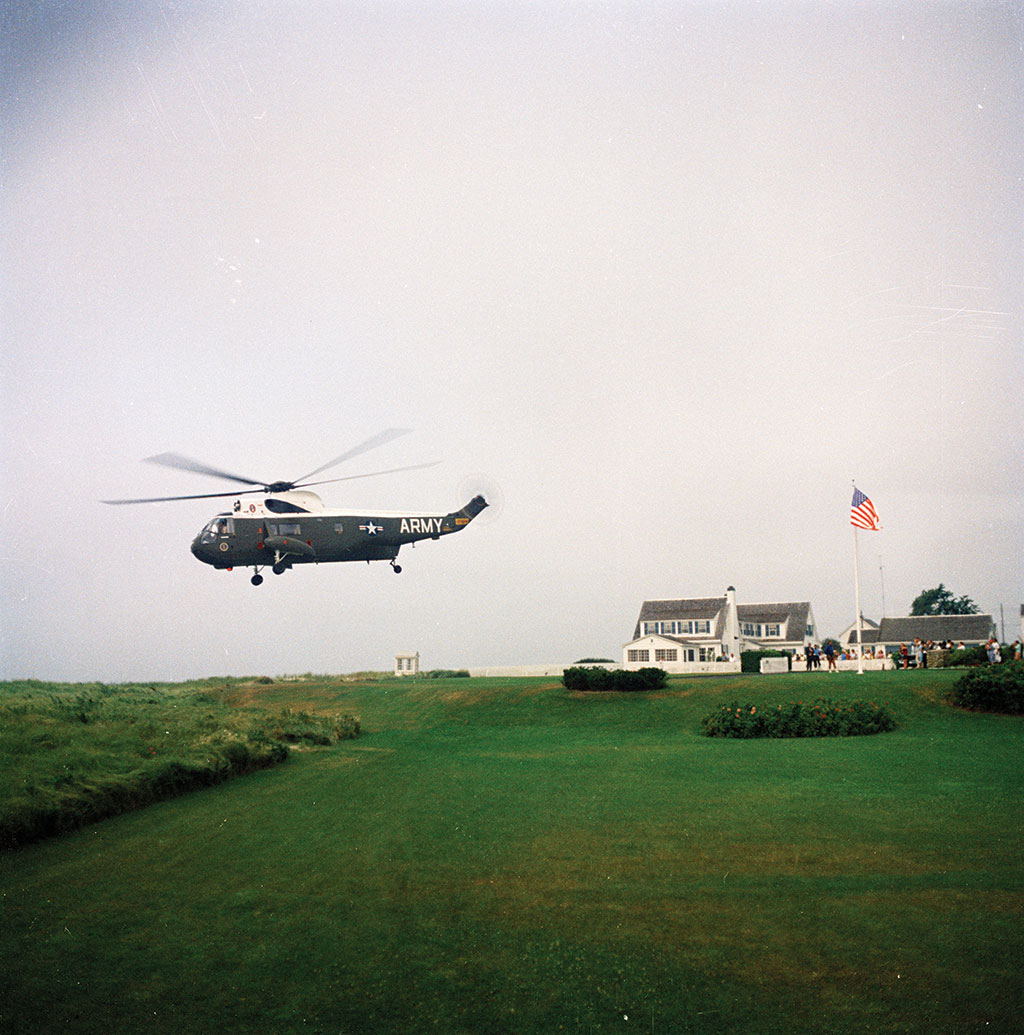
President Kennedy departs the residence of Ambassador Joseph P. Kennedy,
Sr., and Rose Fitzgerald Kennedy on a U.S. Army helicopter following a
weekend in Hyannis Port in July 1962. (Photo courtesy of the JFK
Presidential Library & Museum.)
“Cape Cod was the epicenter of the Kennedys’ family life,” says Rebecca Pierce-Merrick, co-founder, curator and trustee of the JFK Hyannis Museum, which also celebrates its 25th anniversary in July. “President Kennedy loved Cape Cod more than anyplace in the world. The Cape was a place of relaxation for him, a place where he could be himself with his family and friends. But it was also a spot where he could be alone and think.”
The Life & Legacy exhibit, which will be divided into three parts, will first focus on the purchase of the parents’ house in Hyannis Port and how it became the gathering place for multiple generations of Kennedys. “It’s going to be a photo-heavy exhibit, with some multi-media elements and artifacts,” says exhibit designer Roger Westerman, principal of Roger Westerman Design, a full-service design practice that specializes in interpretive and interactive exhibits. “We’ll talk about how President Kennedy developed a special relationship with the Cape, and visitors will also see how important sailing and sports were to the Kennedys in Hyannis Port.”
The Kennedys’ roots were planted in Cape soil during the Roaring Twenties, when the clan’s patriarch, Joe Sr., and his wife, Rose, found a summer cottage in Hyannis Port. After renting for a couple years, the couple purchased it in 1928, a year before Joe shrewdly took his money out of the stock market before it crashed.
Even after the wildly successful Joe had achieved unimaginable wealth, a not-so-subtle anti-Irish sentiment still existed in certain corners of polite New England society, especially the region’s country clubs. While searching for a summer home on Boston’s South Shore and Cape Cod, Joe, a Harvard graduate and a scratch golfer, soon discovered that most clubs weren’t willing to admit an Irish Catholic. “When the family arrived in Hyannis Port, the local golf club was operated by a Catholic,” says Allen. “So that’s how the Kennedys came to Hyannis Port.”
Presidential years and legacy
While coincidental kindness may have brought the Kennedys to the Cape, it is their deep and abiding love for one another, the region, and the ocean that have kept them coming back for nearly a century. As with any successful, wealthy family, most of the Kennedys are scattered throughout the country—and often across the globe—for most of the year. It’s only in Hyannis Port, during the summer, where the entire family spends meaningful time together.
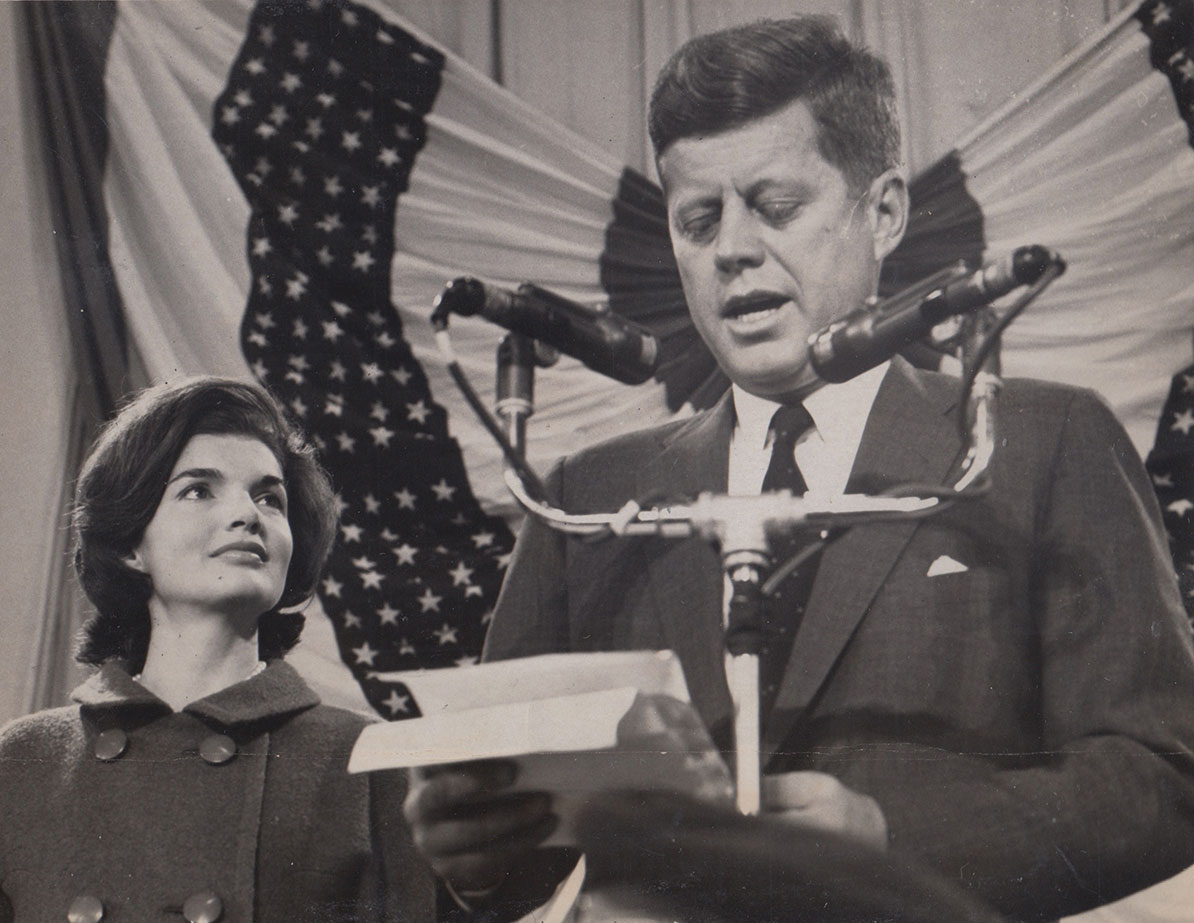
President Kennedy delivers his presidential acceptance speech at the
Hyannis Armory as his wife, Jackie, looks on. (Photo courtesy of the JFK
Presidential Library & Museum.)
Although Jack Kennedy listed 122 Bowdoin Street in Beacon Hill as his “permanent” address, it was Hyannis Port that played a key role in the Kennedy presidency, as depicted in the second part of the exhibit. After Jack and Jackie cast their ballots in Boston on November 8, 1960, the couple came right to the Kennedy Compound, where brother Robert Kennedy maintained the campaign’s unofficial headquarters. When Richard Nixon conceded the tightly contested election in the wee hours of November 9, John Kennedy went to the Hyannis Armory a few hours later to deliver his acceptance speech.
In addition to Cape-related photos of Kennedy’s candidacy and presidency, Life & Legacy will also feature an invitation and ticket to JFK’s inauguration, both from Ann Mulligan, whose father worked for Cardinal Richard Cushing, who had been invited by the president to the ceremony and who had extended the invitation to the Mulligan family. The exhibit also features hand-written correspondence between the Kennedys’ longtime interior designer, Falmouth’s Robert Luddington, and Jackie Kennedy and Rose Kennedy, as well as some of Luddington’s design sketches. The exhibit also features famous—as well as rare—photos of Jack Kennedy’s family life on the Cape.
While Hyannis Port was a place of spiritual sustenance for Kennedy, it was also a place that played a role in the Cuban Missile Crisis, the famous “13 days” when the inexperienced President stood nose to nose with the tough-as-nails Soviet leader, Nikita Khrushchev, and didn’t back down.
In the months leading to the October 1962 crisis, during the most heated period of the Cold War, the superpowers postured publicly during the day while their respective leaders were engaged in some back-room letter writing at night.
While the pen pals never became “besties,” the Democrat and the Communist were able to establish a rapport. Now known as the Kennedy-Khrushchev Correspondence, this secret communication effort enabled both leaders to express their deep desire to avoid Armageddon, which helped them to resolve the crisis without incident.
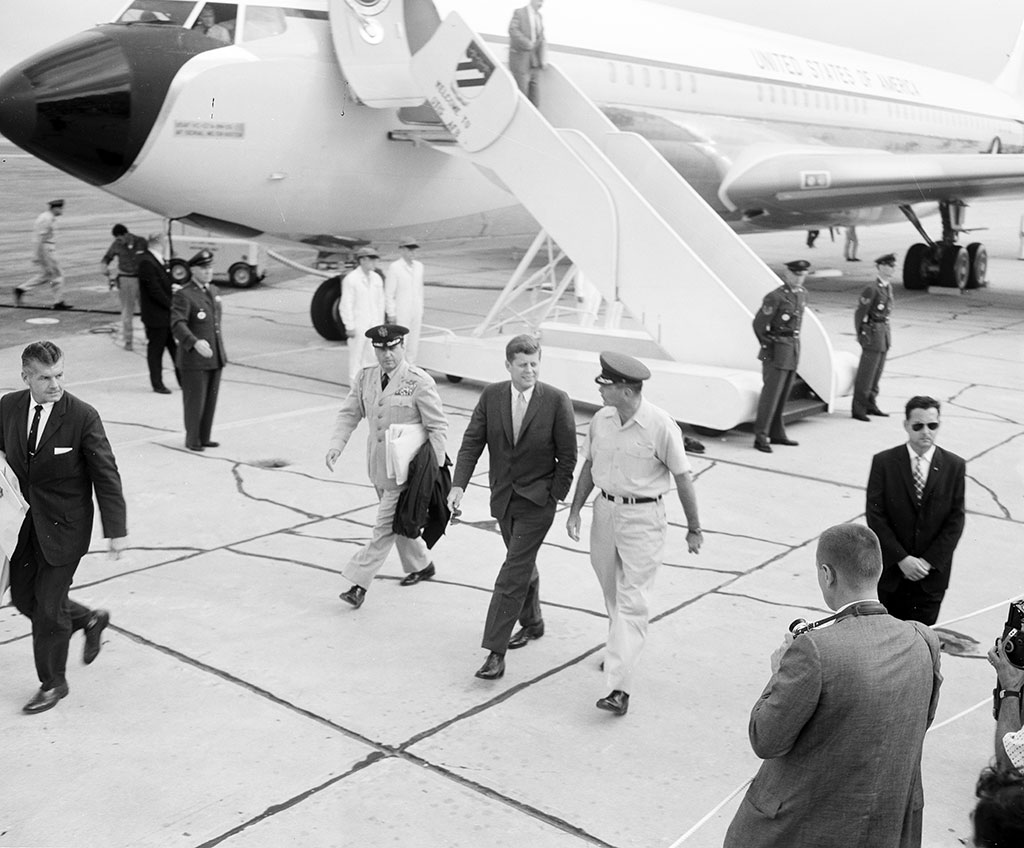
President Kennedy arrives at Otis Air Force Base for a weekend on
Cape Cod in August 1961. (Photo courtesy of the JFK Presidential
Library & Museum.)
In a letter to Khrushchev dated October 16, 1961, Kennedy wrote, “I regret that the press of events has made it impossible for me to reply earlier to your very important letter of last month. I have brought your letter here with me to Cape Cod for a weekend in which I can devote all the time necessary to give it the answer it deserves. My family has had a home here overlooking the Atlantic for many years. My father and brothers own homes near my own, and my children always have a large group of cousins for company. So this is an ideal place for me to spend my weekends during the summer and fall, to relax, to think, to devote my time to major tasks instead of constant appointments, telephone calls, and details.”
In addition to defusing the Cuban Missile Crisis, Jack Kennedy left a broad, lasting legacy—despite his abbreviated presidency. In the final phase of the exhibit, Life & Legacy will examine Kennedy’s establishment of the Peace Corps, the Space Program, the Navy SEALs, the Green Berets, and the Cape Cod National Seashore, among other accomplishments.
“JFK could have easily chosen a life of leisure,” Westerman says. “But he chose a life of public service, including military service for which he was decorated. Given his assassination, one could argue that he sacrificed his life for public service.
“President Kennedy was a gifted speaker and an inspirational leader who connected with people throughout the world,” adds Westerman. “Americans agreed with Kennedy’s optimistic belief that the U.S. was a bastion of democracy, freedom, and good in a world that was troubled. He knew that when Americans work together, we can build a brighter future, which is something that we hope to convey throughout the exhibit.”
The JFK Hyannis Museum is at 397 Main Street, Hyannis. More information on the “Life and Legacy” exhibit can be found at jfkhyannismuseum.org.
Post a comment